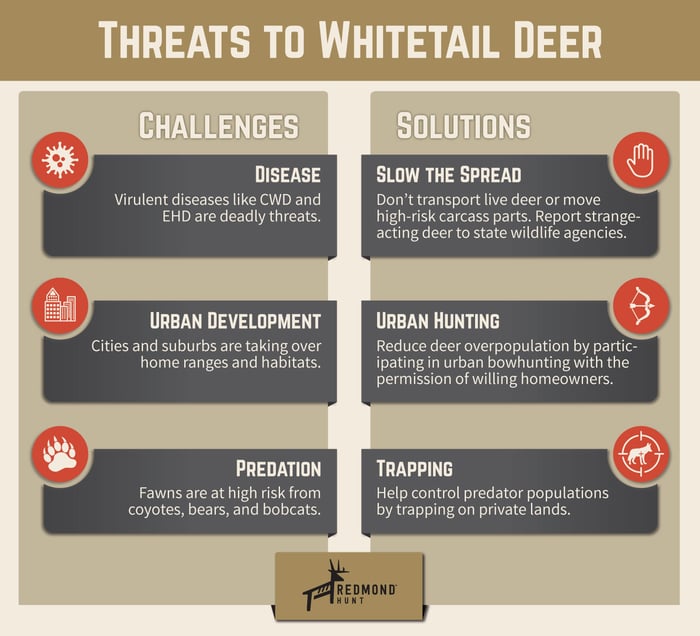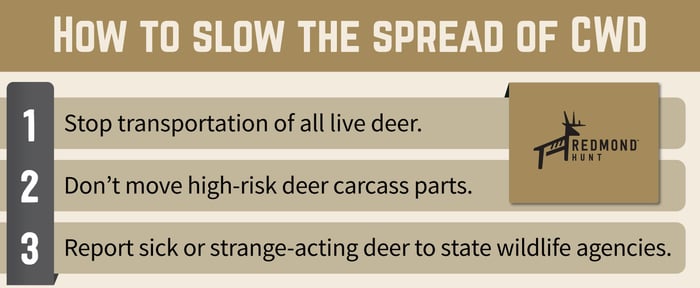© Redmond Hunt 2023. All rights reserved.
Redmond Hunt Blog
Redmond Hunt August 23, 2023
In this blog we cover three problems that interfere with a deer's survival—deer diseases, overpopulation, and predators—and what hunters can do to help.
Across the Unites States some weighty challenges pose threats to the whitetail deer population. While the problems aren’t new, they are ongoing and create uncertainty for whitetail's ability to thrive and survive. Can conservationists, hunters, and deer managers help find answers—or at least good preventions and accommodations—to minimize these threats?
Let's uncover the three most prevalent and pressing problems facing whitetail deer today and the solutions you can participate in to help secure a more solid future for deer herds.
 1. Deer Diseases
1. Deer DiseasesThe most difficult challenge staring down whitetails is disease, and these two deer sicknesses top the list: chronic wasting disease (CWD) and epizootic hemorrhagic disease (EHD). We could devote pages to both—and researchers have—but here we’ll just cover the basics.
This article by the National Deer Association (NDA) describes EHD as a viral infection spread by biting midges, gnats, or “no-see-ums.” EHD emerges more during summer and early fall when heat and drought encourage midge reproduction in stagnant, shallow waters. Five to ten days following exposure, these symptoms of EHD in deer may appear:
The outcome for whitetail deer not previously exposed to epizootic hemorrhagic disease is grim: most will die within five to ten days of contracting the virus.
As bad as EHD is… CWD is worse, and a formidable foe among deer herds. Unlike its viral and bacterial counterparts, chronic wasting disease is caused by a wicked little prion. It's spread by animal-to-animal contact through saliva, urine, and feces.
Once caught, CWD stalks deer like the grim reaper. This neurological disease is virulent, highly contagious, widespread, and 100% fatal—though infected deer may not show symptoms for 18 to 24 months. It causes brain degeneration, emaciation, abnormal behavior, and eventually death. In the realm of deer managment, CWD is the most dreaded three-letter word.
Do you know if your herd has contracted or may be spreading CWD? Centers for Disease Control notes the signs of chronic wasting disease in whitetail deer include:
The onset of frosty weather will send midges into hibernation and end the season’s cycle of EHD. But for chronic wasting disease? There is no cure or sure-fire prevention. There are opinions on how to slow the disease, but most draw heated debate from opposing sides. Feeding and baiting, including deer minerals, is one related hot topic that’s important to hunters, so let’s cover it briefly.
Baiting bans have cropped up across the country because some conservationists feel feeding helps transmit disease through deer congregation and saliva. Others believe supplementing deer with feed and quality minerals like Trophy Rock is important since it creates a healthier animal that can survive challenges better.
Gene Price, a longtime Redmond Hunt team member who sat on the committee for the National Deer Association, has heard the case from both sides—and believes both have valid arguments.
“It’s tough to decipher who’s right,” he said. “Everyone has their own opinion, and you get a really split audience. Most hunters and conservationists like myself lean toward feeding deer to keep them healthier. Others say, ‘Nope, we’re not doing it because it could spread disease.’ It’s the great controversy of the whitetail world: How do we prevent CWD—or is it even preventable?”

There are three things most agree will help slow the spread of chronic wasting disease in whitetail deer:
To learn more, visit the NDA’s Chronic Wasting Disease Resource Center.
Deer need three things to survive: food, water, and cover. Urban development particularly in the eastern U.S. has hacked away at two of those necessities: food and cover. City limits continue to expand, and subdivisions and bedroom communities now engulf chunks of wooded land whitetails once used for foraging and fawning.
Development is a reality, and deer in the city adapt, some finding shelter and feed in backyard bushes, trees, gardens, and birdfeeders. But forced urban living is a major problem for whitetail deer and creates unique challenges like these:
They say you can’t stop progress, so what is the solution to the challenges of urban development for whitetails? One thing humans can do is minimize overpopulation of deer through urban deer hunting. This is especially viable in residential subdivisions with large acreage where you can hunt in the city limits. It does, however, require the cooperation and permission of willing homeowners.
“A good way to introduce urban bow hunting is to talk to and educate landowners as a group, maybe through homeowners’ associations,” Price said. “It’s a common and very rewarding way to help control deer overpopulation and improve the health of herds.”
And it also helps homeowners whose yards and landscaping have been munched on or mowed down by deer. Urban hunting can be a win-win for all.
It’s a natural part of life in the wild: predation—the prey of animals by other predators. Deer predation provides natural herd control but can become a threat to herd survival when deer predators become too populous in rural areas or factors like disease or starvation also take a toll on herds.
This Pennsylvania Game Commission site notes U.S. studies show predators to deer—mostly coyotes, bears, and bobcats—have a substantial impact on populations, particularly young fawns under nine weeks. Predation affects adult deer far less.
Price owns land in Ohio and manages a deer herd which struggles with predation from coyotes and bobcats. Fewer trappers and, in some states, increasing laws against trapping have increased threats to whitetails from predators.
“We try to find trappers to trap our farm, but we just can’t find any,” Price said, “so we try to control the coyotes by hunting and trapping them ourselves. It doesn’t matter if we’re out turkey or deer hunting, if a coyote comes by, that’s our primary target.”
Be aware of trapping and bounty regulations in your area before hunting deer predators or setting out traps.
Knowing the major problems facing whitetail deer can help us better maintain and promote healthier herds. So what can you do? As you’re outdoors, watch for signs of disease in deer and report it to local wildlife agencies immediately. If you live in the city, participate in and promote urban hunting to decrease overpopulation of deer. And if you’re a country dweller, help control predators of whitetail deer by trapping on private lands.
Is deer conservation and land management important to you? At Redmond, we believe hunters help conservation in important ways! Click below to learn four more things you can do to be a better steward over hunting lands and deer herds.
© Redmond Hunt 2023. All rights reserved.